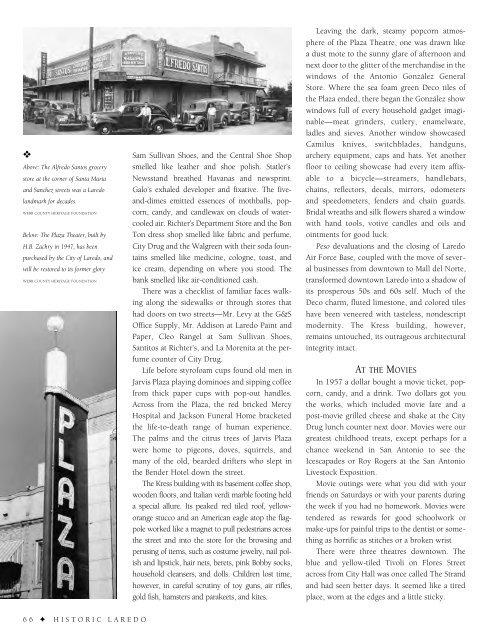Historic Laredo
An illustrated history of the city of Laredo and the Webb County area, paired with the histories of companies, families and organizations that make the region great.
An illustrated history of the city of Laredo and the Webb County area, paired with the histories of companies, families and organizations that make the region great.
Create successful ePaper yourself
Turn your PDF publications into a flip-book with our unique Google optimized e-Paper software.
❖<br />
Above: The Alfredo Santos grocery<br />
store at the corner of Santa María<br />
and Sanchez streets was a <strong>Laredo</strong><br />
landmark for decades.<br />
WEBB COUNTY HERITAGE FOUNDATION<br />
Below: The Plaza Theater, built by<br />
H.B. Zachry in 1947, has been<br />
purchased by the City of <strong>Laredo</strong>, and<br />
will be restored to its former glory<br />
WEBB COUNTY HERITAGE FOUNDATION<br />
Sam Sullivan Shoes, and the Central Shoe Shop<br />
smelled like leather and shoe polish. Statler’s<br />
Newsstand breathed Havanas and newsprint.<br />
Galo’s exhaled developer and fixative. The fiveand-dimes<br />
emitted essences of mothballs, popcorn,<br />
candy, and candlewax on clouds of watercooled<br />
air. Richter’s Department Store and the Bon<br />
Ton dress shop smelled like fabric and perfume.<br />
City Drug and the Walgreen with their soda fountains<br />
smelled like medicine, cologne, toast, and<br />
ice cream, depending on where you stood. The<br />
bank smelled like air-conditioned cash.<br />
There was a checklist of familiar faces walking<br />
along the sidewalks or through stores that<br />
had doors on two streets—Mr. Levy at the G&S<br />
Office Supply, Mr. Addison at <strong>Laredo</strong> Paint and<br />
Paper, Cleo Rangel at Sam Sullivan Shoes,<br />
Santitos at Richter’s, and La Morenita at the perfume<br />
counter of City Drug.<br />
Life before styrofoam cups found old men in<br />
Jarvis Plaza playing dominoes and sipping coffee<br />
from thick paper cups with pop-out handles.<br />
Across from the Plaza, the red bricked Mercy<br />
Hospital and Jackson Funeral Home bracketed<br />
the life-to-death range of human experience.<br />
The palms and the citrus trees of Jarvis Plaza<br />
were home to pigeons, doves, squirrels, and<br />
many of the old, bearded drifters who slept in<br />
the Bender Hotel down the street.<br />
The Kress building with its basement coffee shop,<br />
wooden floors, and Italian verdi marble footing held<br />
a special allure. Its peaked red tiled roof, yelloworange<br />
stucco and an American eagle atop the flagpole<br />
worked like a magnet to pull pedestrians across<br />
the street and into the store for the browsing and<br />
perusing of items, such as costume jewelry, nail polish<br />
and lipstick, hair nets, berets, pink Bobby socks,<br />
household cleansers, and dolls. Children lost time,<br />
however, in careful scrutiny of toy guns, air rifles,<br />
gold fish, hamsters and parakeets, and kites.<br />
Leaving the dark, steamy popcorn atmosphere<br />
of the Plaza Theatre, one was drawn like<br />
a dust mote to the sunny glare of afternoon and<br />
next door to the glitter of the merchandise in the<br />
windows of the Antonio González General<br />
Store. Where the sea foam green Deco tiles of<br />
the Plaza ended, there began the González show<br />
windows full of every household gadget imaginable—meat<br />
grinders, cutlery, enamelware,<br />
ladles and sieves. Another window showcased<br />
Camilus knives, switchblades, handguns,<br />
archery equipment, caps and hats. Yet another<br />
floor to ceiling showcase had every item affixable<br />
to a bicycle—streamers, handlebars,<br />
chains, reflectors, decals, mirrors, odometers<br />
and speedometers, fenders and chain guards.<br />
Bridal wreaths and silk flowers shared a window<br />
with hand tools, votive candles and oils and<br />
ointments for good luck.<br />
Peso devaluations and the closing of <strong>Laredo</strong><br />
Air Force Base, coupled with the move of several<br />
businesses from downtown to Mall del Norte,<br />
transformed downtown <strong>Laredo</strong> into a shadow of<br />
its prosperous 50s and 60s self. Much of the<br />
Deco charm, fluted limestone, and colored tiles<br />
have been veneered with tasteless, nondescript<br />
modernity. The Kress building, however,<br />
remains untouched, its outrageous architectural<br />
integrity intact.<br />
AT THE MOVIES<br />
In 1957 a dollar bought a movie ticket, popcorn,<br />
candy, and a drink. Two dollars got you<br />
the works, which included movie fare and a<br />
post-movie grilled cheese and shake at the City<br />
Drug lunch counter next door. Movies were our<br />
greatest childhood treats, except perhaps for a<br />
chance weekend in San Antonio to see the<br />
Icescapades or Roy Rogers at the San Antonio<br />
Livestock Exposition.<br />
Movie outings were what you did with your<br />
friends on Saturdays or with your parents during<br />
the week if you had no homework. Movies were<br />
tendered as rewards for good schoolwork or<br />
make-ups for painful trips to the dentist or something<br />
as horrific as stitches or a broken wrist<br />
There were three theatres downtown. The<br />
blue and yellow-tiled Tivoli on Flores Street<br />
across from City Hall was once called The Strand<br />
and had seen better days. It seemed like a tired<br />
place, worn at the edges and a little sticky.<br />
66 ✦ HISTORIC LAREDO
















